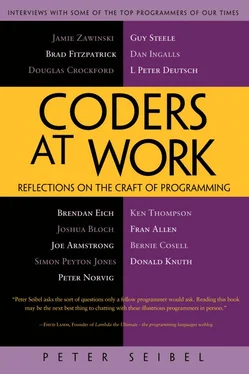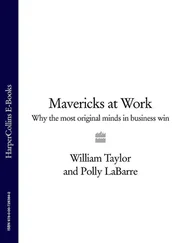Peter Seibel - Coders at Work - Reflections on the craft of programming
Здесь есть возможность читать онлайн «Peter Seibel - Coders at Work - Reflections on the craft of programming» весь текст электронной книги совершенно бесплатно (целиком полную версию без сокращений). В некоторых случаях можно слушать аудио, скачать через торрент в формате fb2 и присутствует краткое содержание. Жанр: Программирование, на английском языке. Описание произведения, (предисловие) а так же отзывы посетителей доступны на портале библиотеки ЛибКат.
- Название:Coders at Work: Reflections on the craft of programming
- Автор:
- Жанр:
- Год:неизвестен
- ISBN:нет данных
- Рейтинг книги:3 / 5. Голосов: 1
-
Избранное:Добавить в избранное
- Отзывы:
-
Ваша оценка:
- 60
- 1
- 2
- 3
- 4
- 5
Coders at Work: Reflections on the craft of programming: краткое содержание, описание и аннотация
Предлагаем к чтению аннотацию, описание, краткое содержание или предисловие (зависит от того, что написал сам автор книги «Coders at Work: Reflections on the craft of programming»). Если вы не нашли необходимую информацию о книге — напишите в комментариях, мы постараемся отыскать её.
Coders at Work
Founders at Work
Coders at Work: Reflections on the craft of programming — читать онлайн бесплатно полную книгу (весь текст) целиком
Ниже представлен текст книги, разбитый по страницам. Система сохранения места последней прочитанной страницы, позволяет с удобством читать онлайн бесплатно книгу «Coders at Work: Reflections on the craft of programming», без необходимости каждый раз заново искать на чём Вы остановились. Поставьте закладку, и сможете в любой момент перейти на страницу, на которой закончили чтение.
Интервал:
Закладка:
Allen:Right.
Seibel:You must have observed many shifts in attitudes along those lines.
Allen:Well, today they wouldn’t say great programmers, but they’re great on teams because they like to collaborate. It shifted to women collaborate and they work together well. So that’s today’s analog of that earlier assumption that women were quite detail-oriented.
Seibel:Despite the number of women in that Stretch compiler group, you must have also have had times in your career when you were working almost entirely with men. Was it a different kind of experience working in a group with lots of women?
Allen:Yes. I think it was, but it was not only lots of women—a lot of my peers were truly peers in the sense that they were mostly all the same age because of this big hiring that was going on at the point I was hired. We were pretty much all the same age and pretty much of the same background. So it was a very collegial group. And also, the whole area was so new—so much was unknown. We didn’t know what we didn’t know, but it wasn’t as if there were a lot of people around us that had years of experience or knew a whole lot more.
Seibel:So what happened? The field is not full of women anymore; when did that change?
Allen:It took me quite a few years to identify the cause. It happened in the late ’60s, at least in the environments that I was in. I had left Research to be involved with the ACS project and went to California. Then I came back to the Research division and found it a very, very different environment than the one I had left essentially eight years earlier.
There was a significant glass ceiling. There were processes in place, lines of management. And the management structures had changed and decisionmaking had become much more formal, particularly about what projects to do and how to do them. And the number of women had changed and the position of women in the organization had significantly changed, and not for the good. And I was not happy about it, obviously.
In 1970, ’71, ’72, I was 19 years or 18 years into a career that was just full of fun and opportunity. I never saw myself as advancing, but I felt I had the freedom to do what I felt was right and to work on interesting things in roles that I would enjoy. And I came back and found out that wasn’t the case.
Seibel:Do you think that glass ceiling had, in fact, been there before and you hadn’t bumped up against it yet? Or had something changed?
Allen:It really hadn’t been there previously. Recently I realized what was probably the root cause of this: computer science had emerged between 1960 and 1970. And it mostly came out of the engineering schools; some of it came from mathematics.
And the engineering schools were mostly all men in that period. And the people IBM was hiring had to meet certain requirements: have certain degrees and have taken certain courses in computer science. And so they were almost all men because they were the ones that satisfied the requirements—because it was a discipline now. The other thing that seemed to have happened is that it was a profession—there were a lot of processes in place and chains of management that implemented the processes and kept everything running smoothly. So it was a very different place.
Seibel:I’m pretty sure sexism in society at large was pretty rampant in the ’50s and ’60s. Yet in that period you were working in groups that had lots of women in them. Why was it so open to women then?
Allen:Software was the newest-of-the-new stuff that was going on. And it’s also probably still to this day considered a soft part of the science. And that’s where women gravitated. Early on they were programmers on ENIAC and at Bletchley Park. Women were the computers—that was their name. But in engineering and physics and the harder, older sciences there weren’t as many women. It was just divided that way, early on.
Then women started to come out of the engineering schools. Now the undergraduate percentage of women in engineering is somewhere around 20 percent. Carnegie Mellon would be much higher than that—they have made a special effort. But in computer science, it’s essentially 8 percent. There’s no domain that is as bad as computer science for women right now in terms of numbers. “Bad” is the wrong word—it’s low.
Seibel:To play devil’s advocate, why does it matter whether we achieve, say, Anita Borg’s goal of “50/50 by 2020,” meaning 50 percent women in computer science by the year 2020? Why does it matter whether this one particular field be representative of the population at large?
Allen:It’s such a transformative field for society as a whole. And without the involvement of a diverse group of people, the results of what we do are not going to be appealing or useful to all aspects of our society. A piece of our challenge is to make computing, and all that it enables, accessible to everyone. That’s an ideal. But it’s really where it’s going—the work at MIT on the $100 computer and the way we’re trying to enable commerce at a very low level through computing in the remote areas of underdeveloped countries.
Seibel:So clearly the closer you get to the end user, the easier it is to imagine that people with diverse experiences are going to bring different ideas about how those users might like to interact with a computer. Again playing devil’s advocate, what do you say to someone who says, “That’s all well and good when we’re talking about designing applications, but when you’re designing compiler optimizations, who cares about a diversity of point of view?” Is it still valuable to have a diverse staff even when you’re working on extremely technical aspects of software, like optimizing compilers?
Allen:Yes. In fact, that was one of the keys to the PTRAN group. A lot of women were attracted to the group, partly because there were other women there already. But it also made the group a very congenial group. And it was because of the mix—it wasn’t because there were women there, but because of the mix. These people came from other organizations here, but also other educational backgrounds.
I had people that came in from NYU—the Courant Institute—who had their own way of thinking about doing things because they’d come through the same graduate school. And then I had a couple people from MIT. One in particular—a woman—was on the very theoretical side and a very wonderful thinker in a different way. The Illinois people had some different characteristics. So even taking out the gender differences or other cultural differences, the fact that they came from these different places provided, in and of itself, a much stronger group.
Seibel:I suppose if we get to the point where undergraduate computer science is split 50/50 by gender we could actually lose some of that experiential diversity, if everyone is going through the same sort of CS degree.
Allen:What makes some of the new graduates very appealing to, say, IBM, is that they’re not staying in one discipline. They move from one discipline to another. And they can be deeply technical but very diverse disciplines. Often it’s done purposefully—a person decides that they want to connect some big fields. I’ve talked to some people like that—they see a connection between working in linguistics and working in computing. They’re very appealing as an employee.
Seibel:So how are you feeling about the “50/50 by 2020” project?
Allen:Pretty discouraged about it.
Читать дальшеИнтервал:
Закладка:
Похожие книги на «Coders at Work: Reflections on the craft of programming»
Представляем Вашему вниманию похожие книги на «Coders at Work: Reflections on the craft of programming» списком для выбора. Мы отобрали схожую по названию и смыслу литературу в надежде предоставить читателям больше вариантов отыскать новые, интересные, ещё непрочитанные произведения.
Обсуждение, отзывы о книге «Coders at Work: Reflections on the craft of programming» и просто собственные мнения читателей. Оставьте ваши комментарии, напишите, что Вы думаете о произведении, его смысле или главных героях. Укажите что конкретно понравилось, а что нет, и почему Вы так считаете.












